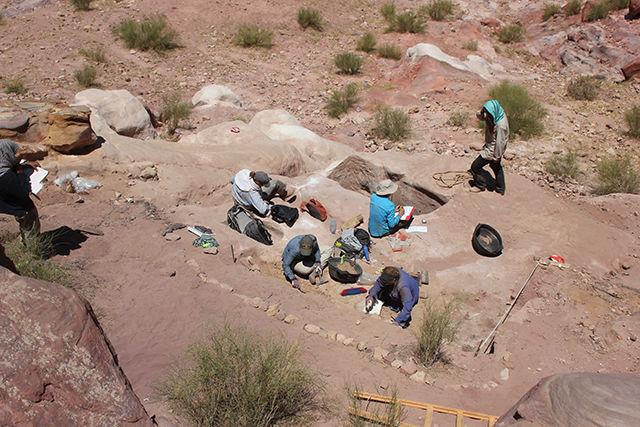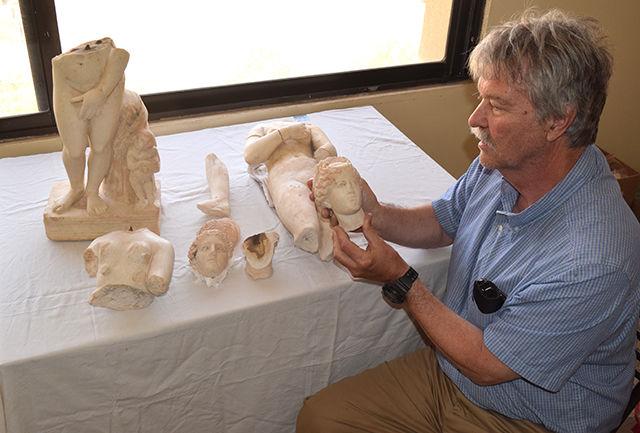A team of students and archaeologists recently uncovered a clue to Roman influence on an ancient Arab people in Petra, Jordan.
Under the direction of archaeologist Tom Parker, a history professor at NC State, and bioarchaeologist Megan Perry, an anthropology professor at ECU, researchers unearthed two marble Aphrodite statues.
The project, which is in southwest Jordan, focuses on the “non-elites” of Petra. Known for its monumental structures, the city is already a well-known archaeological hub. Voted one of the New Seven Wonders of the World, Petra isn’t short of grand structures: Its ornate, outcropped façade and the Palace Tombs, are famous to Indiana Jones and the Last Crusade fans, while its great tunnels and theaters are famous to the more archaeologically informed.
The abundance of grand archaeological sites directly influences the kind of research typically found in the area, with the vast amount of research conducted focusing on wealthy, urban areas. The people behind the North Ridge Project have different intentions, however.
“All the monumental stuff, while exciting, reveals almost nothing about the ordinary people who built and lived in Petra,” Parker said.
Instead, researchers of the three-term project examined homes and tombs of commoners, hoping to piece together the culture of the Nabataean people who have been largely overlooked.
In tombs, excavators retrieved human remains and domestic artifacts. A trained bioarchaeologist can examine bones to find information regarding a person’s health, giving insight to the Nabataeans’ health history, their age, sex and diet. Artifacts in the tomb show what was precious to the families buried there. Within homes, relics like pottery and jewelry revealed evidence of daily life, providing clues concerning cultural routines and class.
Researchers spent their days how one may typically imagine an archaeologist’s: hours tediously removing layer after layer, carefully collecting bits of broken pottery.
The day typically started before sunrise.
“They say wake up at 5:00,” said Adam Connell, a junior studying genetics and anthropology. “In reality it was more like 4:45 a.m. — we had to get ready, and eat breakfast, and get ready and everything. And that was six days a week, [for five weeks]. We’d get to the site around 6 and work until 9 a.m., when we’d have second breakfast. Then we’d work until 1, when we’d shut everything down. We’d come back to the house and have lunch [and a nap], and after that, we had to wash all the pottery.”
The team would have dozens of buckets of pottery that needed to be cleaned and sorted. Onsite ceramists would then determine their worth, looking for pieces that were “diagnostic,” or helped determine more about the time period. Only a small percent of the sherds was worth keeping.
For the most part, the artifacts were what the researchers expected. The Aphrodite statues, however, were much of a surprise.
“It was not what anyone expected to see,” said Rebecca Biggerstaff, a junior studying anthropology. “No one thought that they’d be there, let alone that we could find them.”
The statues were found in an urban villa with an internal bath. Originally, they may have been in an elite home or a temple.
“An earthquake in the second century caused widespread destruction in the area; it’s likely they had fallen and broken, been cleaned up and dumped in the abandoned house,” Parker said. “They testify the impact on Greco-Roman culture on these Nabatean Arabs who were once independent, but were eventually incorporated into the Roman Empire.”
When first uncovered, word spread quickly across the site, which had been just about to shut down for the day.
“We completely evacuated area C, our structure, and we ran up the hill,” Biggerstaff said. “Everyone, the whole team, was crowded around this one little trench area, E3, so we just kind of snuck in there. And we saw, literally, the butt of Aphrodite. It had just been exposed. It was so smooth and so pretty. Everyone was just standing in awe.”
The museum-quality statues are once-in-a-lifetime finds for the archaeologist. For students, however, the once-in-a-lifetime experience goes beyond the exquisite find.
“We’ve been richly rewarded,” Parker said. “I’m grateful to have the opportunity to do this, I’m blessed, especially with such a great team. Opening the eyes of students, for their first international experience for many of them, to see what field research is like, to work alongside local people in a Muslim/Arab country. These are precious experiences [for students who] go on in engineering and accounting; these are some of the greatest experiences of their lives.”
Researchers, including students, are working on the initial follow-up now, working with inventory in a lab on campus.
“It’ll be a year or more before we actually analyze it,” Connell said. “Right now there’s just this massive volume of data we need to sort and put in some kind of organizational structure. It’ll be a long time before we can even figure out all that we’ve learned from the data.”
Regardless of what time brings in terms of data, these statues and the other artifacts will both help elucidate the people of the Nabataean empire and leave students with unforgettable experiences.
NC State history professor Tom Parker examines the head of an Aphrodite statue. The statue was unearthed as part of an excavation trip in Petra, Jordan.









